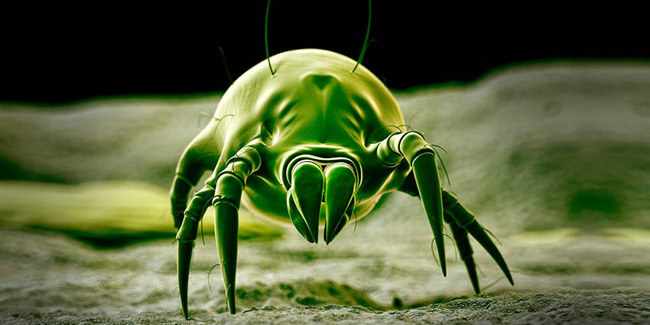Have you ever been disturbed while sleeping? Maybe you feel the itching on the skin of the body? or Do you start coughing after waking up? or even you have trouble breathing when you wake up? Maybe it is caused by a small animal called mites, or often called lice. These mites often sit on cushions and mattresses that you use during sleep. Mites breed easily on sleeping pillows and mattresses. This can trigger allergies with unpleasant symptoms. Even if you are not really allergic to mites, you should periodically take these steps to eliminate them for your hygiene and health.
What are dust mites / mites?
Mites are an eight-legged creature that is almost impossible to see with the naked eye, should be with a microscope. Dust mites feed on fragments of human skin that are detached, and it is therefore common that mites live wherever humans live. Dust mites will live in the cleanest house, so it is very difficult to remove.
Specifically, dust mites can often be found in places that are related to your sleeping activities, as they are usually living mites where there are many dead skin fragments. Dust mites also thrive in places with high humidity. Pillows and Mattresses are places that meet this requirement because peeling skin and sweat is an ideal source of food and moisture for mites. Dust mites cause problems because they secrete enzymes. This enzyme can trigger allergic reactions in the human body. It can cause symptoms such as sneezing, wheezing, coughing, or watery eyes. Dust mites do not cause problems for those who are not allergic to them, because dust mites do not bite or hide in the skin.
Well this time we will tell you how to remove the mite from the pillow or mattress that you use to sleep every day, so you avoid the risk of itching, yeast infection, allergies, cough and asthma. We will not discuss the method of cleaning the mites on the mattress, we will only discuss how to clean the pillow from the mite. Though more or less the same way. Here are a few different methods of removing dust mites from your pillows:
How to Clean your Pillows from Dust Mites
Read the Instruction on Pillows Tag
Before you read the information below, it should be noted that you should always follow the Maintenance guidelines in the tag. If your pillow has no tags, the information below will be useful to ensure that you do not damage it during the cleaning process. However we recommend that you comply with the cleaning instructions in the attached tag. What's in it? Usually there are codes like
dry or wet clean or temperature information.
dry or wet clean or temperature information.
You have to find out what type of pillow you want to wash. What materials are in it? Here are the most common types of pillows, with a quick overview of how to get started.
Kapok Pillow, This pillow can not be washed, can only be dried under the sun alone.
Foam Pillow, Foam pillows should not be put into a washing machine or overheated in excessive amounts.
Foam Pillow, Foam pillows should not be put into a washing machine or overheated in excessive amounts.
Goose Down / Down Feather & Silicon Fiber Pillows. Generally, both types of pillows can be washed with your washing machine or hand-cleaned manually. Clean until completely dry. if it should be dried, do not get too hot because it will damage the density of the pillow.
Latex, This kind of pillow can be washed with machine.
Remove the Pillowcase
Latex, This kind of pillow can be washed with machine.
Remove the Pillowcase
If there is a cover, you should remove it and wash it separately. The majority of pillowcases can go into the washing machine, but again, look for care instructions on the tags. If you use a special hypoallergenic cover pillow, then a special way may be required.
Using Vacuum Cleaner
Use a Vacuum cleaner to remove dust and dirt that might be trapped inside the pillow. It will not clean up completely, but it will help remove any debris left behind. It will be helpful to wash the pillow itself.
Use a Vacuum cleaner to remove dust and dirt that might be trapped inside the pillow. It will not clean up completely, but it will help remove any debris left behind. It will be helpful to wash the pillow itself.
Do Not Overheating
Since this is a foam or down or silicon pillow, You should not expose it to excessive heat. Specifically, this means you should not put it in the dryer or leave it under the sun too long. You can put it in the dryer on no heat cycles for about 20 minutes to help free the dust, dirt and debris.
Since this is a foam or down or silicon pillow, You should not expose it to excessive heat. Specifically, this means you should not put it in the dryer or leave it under the sun too long. You can put it in the dryer on no heat cycles for about 20 minutes to help free the dust, dirt and debris.
If there are visible stains, you can use a cloth dipped in soft soap and water to help clean it. There are a number of other natural cleaning solutions that you should consider to use as well. Be sure to rinse the entire area with a damp cloth and let it dry thoroughly before using it again.
Washing by Hand
Some pillows have instructions for washing by hand. If you choose to do this, be careful as the pillow becomes wet, heavy and can be easily damaged or torn. Make sure you leave it completely dry before you use it again. A fan may be able to help speed this process.
Use a Pillowcase that Changes Regularly.
We recommend wearing a pillowcase to protect the pillow from dust mites. There are many benefits of using a pillowcase, one of which is to keep the pillow clean. Pillowcases will help reduce how often you have to clean the pillow, and it will also prolong life and help protect you from harmful allergies. If you have a hypoallergenic pillow cover, that would be better.
How often to wash the pillow regularly.
Now that you know more about how often to wash the pillows regularly, you may wonder how you should do it. It depends on how often the pillow is used. If you sleep with the pillow every night, then you should often wash it. But if it is a decorative pillow located on top of the furniture, which is rarely used, then you can clean it less often.
There is no definite answer as to how often you should clean it up. Opinions will vary depending on who you listen to. Some say half a year, while others say it should be once a month. We choose to suggest just follow your instincts. If you feel your pillows need to be cleaned, then wash them immediately. But remember, if you use a pillowcase, you should wash it more often than the pillow
itself.




No comments:
Post a Comment